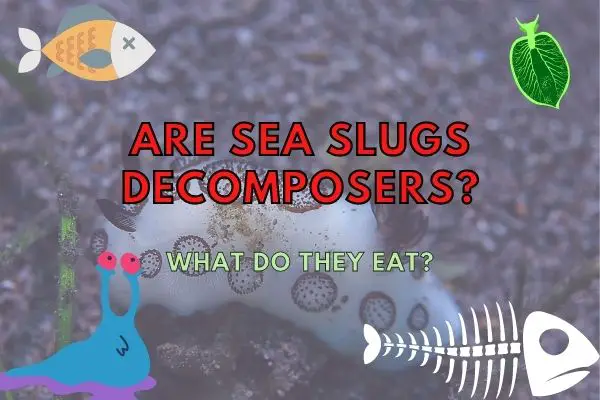Sea slugs are a type of mollusc that live in the ocean. Like all gastropod molluscs, they have a soft body that, contrary to snails, is not protected by a hard shell. Sea slugs have lost their shell during the course of evolution and instead rely on other methods of defence – such as venom!
Whereas some sea slugs behave as decomposers (or scavengers, to be precise) they are primarily omnivores. Sea slugs feed on a wide variety of food items of plants and animals – dead or alive! These include algae, sponges, other animals and carrion. They are also known to eat other sea slugs!
As well as being important members of the marine food web, sea slugs play an important role in coral reef ecosystems. This is because they help to control the growth of algae on reefs which can otherwise smother and kill corals.
Contents
Habitat and Diet of Sea Slugs
Sea slugs are found in marine habitats all over the world. They are especially common in coral reefs and other areas with a lot of plant life.
Most mollusks prefer shallower waters. Mussels can be found on intertidal rocks. Giant clams live in coral reefs and snails can be found on intertidal rocks, in coral reefs, or buried in the sand of beaches or the ocean floor.
Whereas most are found at the bottom layers of the ocean, others like to crawl or even float closer to the surface!
Sea slugs are omnivores, which means they eat both plants and animals. They mostly eat living plants, corals, sponges and algae, but they are also important feeders on decomposing plant matter and they will also eat dead fish, squids, whales etc. if they encounter them.
Sea slugs tend to eat:
Sponges
Corals
Aquatic plants
Other sea slugs
Anemones
Hydroids
Dead fish
Bryozoans
Seaweed
Tunicates
Algae
Carrion
Feeding Habits of Sea Slugs
Sea slugs use their radula (a tongue-like structure) to scrape food off of rocks and other surfaces. Some sea slugs use their tongue to scrape food off surfaces or to drill holes into prey.
They then digest the food in their stomachs. Some sea slugs also have symbiotic relationships with some algae that produce energy for them!
Some sea slugs live on or near the plant and get some of its food from the plant. In return, the sea slug provides the plant with nutrients from its faeces that it needs to grow.
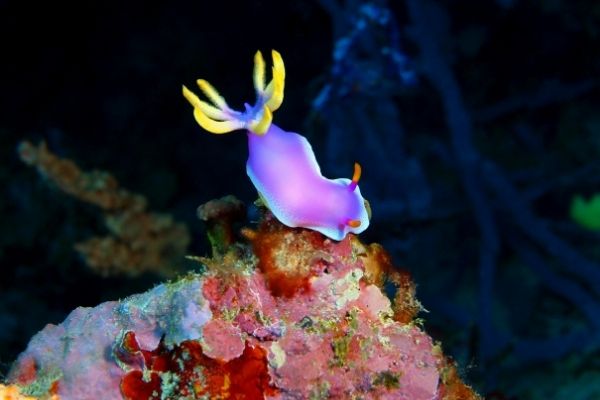
Some sea slugs are also filter feeders and are equipped with long christmas tree like tentacles that catch algae and plankton from the water flowing by!
Can Sea Slugs be Considered Decomposers?
Slugs are important carrion feeders but can also feed on plant material or small organic particles in the sand.
While sea slugs may occasionally eat dead animals or carrion, they are not primarily scavengers or detritivores. This, however, does not mean they do not play an important role in decomposition of organic matter!
Most sea slugs will indeed act as scavengers by eating dying animals, especially the softer ones like sea sponges, sea cucumbers and cephalopods, like octopuses, if they come across them in their search for food!
Some act more like decomposers than other. For example, sea slugs such as the grey side-gilled sea slugs are more likely to seek out dead or dying animals that they eat as decomposers of the ocean!
Along with other mollusks, Crustaceans, Echinoderms and Marine worms, seas slugs are among the most important decomposers of the ocean!
Are sea slugs Carnivores, Herbivores or Omnivores?
Sea slugs are omnivores because they eat a wide variety of food, including animals. While most sea slugs eat algae and aquatic plants, some sea slugs also eat small invertebrates like copepods, ostracods, nudibranchs, gastropods, bivalves, echinoderms, arthropods and even other sea slugs.
Are Sea Slugs Producers, Consumers or Decomposers?
Sea slugs are primarily consumers because they eat other living organisms. Sea slugs are omnivores, which means that they eat a variety of organisms, including animals and plants.
However, as shown in the next section, there is one example of a sea slug that is a producer!
Are Sea Slugs Autotrophs or Heterotrophs?
Sea slugs are heterotrophs because they eat other living organisms. Practically no animals are autotrophic because animals do not get their energy directly from the sun like plants do.
That is, animals like the slugs cannot make their own energy, but need to eat other organisms as their energy and carbon source.
However, there are indeed sea slugs that can (almost) be considered autotrophs!
Have you heard of the species of sea slugs called Elysia cholorotica that is green like algae? This is in fact because they contain algae DNA in their cells!
As it turns out, this sea slug is categorized as a producer! Scientifically, this is the first member of the animal kingdom that is notable for its ability to produce chlorophyll which in turn, is the pigment needed during the process of photosynthesis; effectively making it an autotroph.
I know I have mentioned this fascinating animal before in my post about animal autotrophs, but I really can’t help but mention this slug when I get the chance!
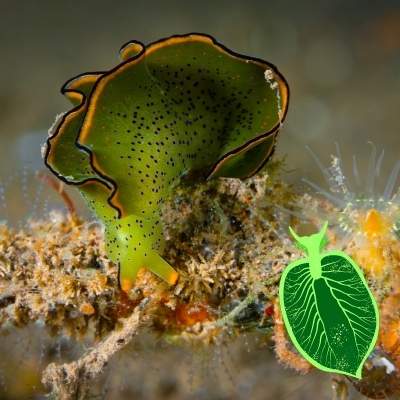
There are a few other animals able to exploit algae to produce energy from the sun, but none like the Elysia cholorotica snail making photosynthesis on its own!
As such, snails could in theory take the role of producers just like one of their cousins, the Elysia sea slug, has already done.
What Type of Consumer is a Sea Slug?
Sea slugs are omnivores, which means that they eat a variety of organisms, including animals. Generally, herbivores are primary consumers, omnivores secondary consumers and predators are tertiary consumers.
Where are Sea Slugs in the Food Chain?
Sea slugs are not considered to be primary or secondary consumers because they eat animals, which are generally considered to be tertiary consumers.
Snails sit between the 3rd and 2nd trophic levels as they can both be carnivores and herbivores, but mostly eat plants and therefore often depicted at the 2nd trophic level as primary consumers.
Sea slugs are basically the same place in the food chain as sea snails (that I wrote about recently here). And I will show you the same figure:
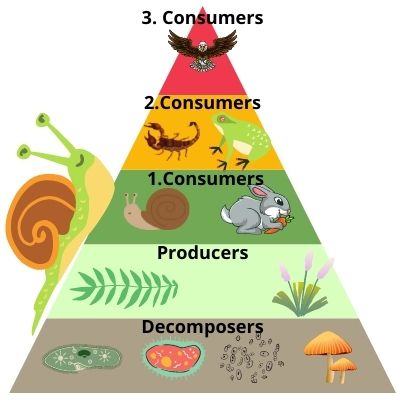
What Animals Prey on Sea Slugs?
Sea slugs are food for a variety of animals including multiple fish species, crabs, sea stars, octopuses, other sea snails and slugs, sea cucumbers, lobsters, sea anemones and humans!
However, some sea slugs have developed poisonous defences to protect themselves.
These venomous sea slugs, like the aeolid sea slugs, are mostly found in warm, tropical waters around the world and are characterized by their brightly colored bodies and the presence of venom-producing glands.
Another example is the famous blue sea slugs (Glaucus atlanticus) that really looks like something from outer space!
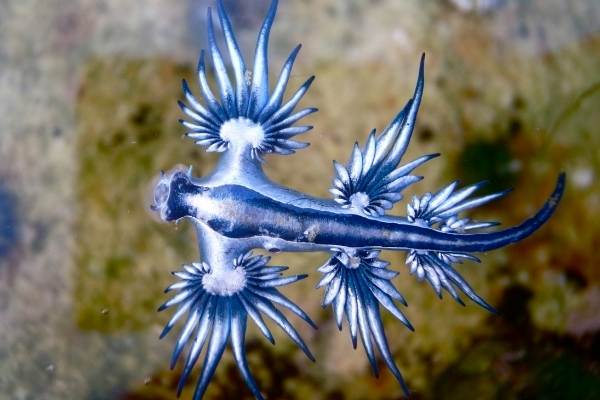
While they may look colorful and harmless, their venom can be quite dangerous to humans and other animals. In some cases, it can even be fatal. If you come into contact with one of these creatures, it is important to seek medical attention immediately.
Conclusion
In this post I have looked into the diet of the sea slug!
Snails and slugs are quite similar organisms. However, the obvious difference lies in the fact that snails contain shells while slugs do not possess these shells. Both of these organisms belong to the group of soft-bodied organisms categorized under mollusks.
I have written an article on snails within the same topics mentioned here.
Sea slugs are a fascinating group of animals that have a very interesting life cycle. I have looked into the role of sea slugs in the marine food web, and how they are important decomposers in the sea!
Sea slugs are an interesting group of animals, and they are very important in the food chain in the sea! They are not just useful to us as food, but they also have a very important role in the marine environment.
They are important decomposers of dead animals in the sea and they also have an almost symbiotic relationship with many other marine organisms! They are also useful to the marine environment because they help to recycle nutrients, and they are also a food source for many other marine organisms.
I hope you enjoyed reading this post, and I do encourage you to read my other posts on this blog for more exciting facts about animals and their diets!

